
Groundhogs also known as Woodchucks
Groundhogs, commonly known as woodchucks or by their scientific name Marmota monax, are a type of rodent belonging to the family Sciuridae. Indigenous to North America, these animals are recognized for their burrowing habits and have become an integral part of the ecosystem across the Eastern United States, Canada, and into Alaska. Groundhogs play a significant role in their habitats by aerating the soil and promoting plant growth through their digging activities, although they can also create conflicts with human agricultural practices.
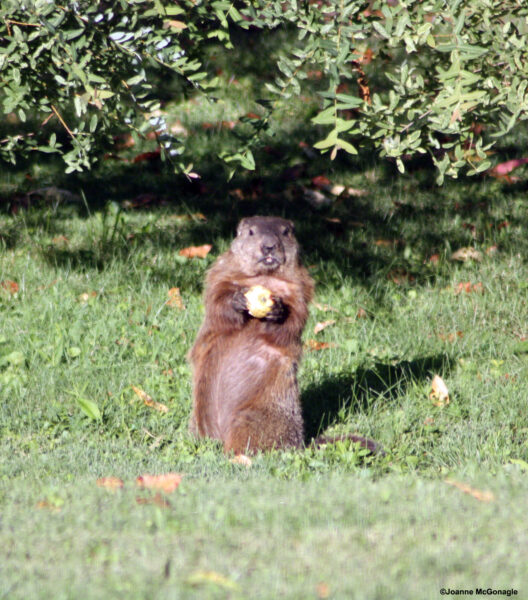
We have groundhogs in our backyard, who have also burrowed underneath our sunroom to hibernate for the winter. Each Spring, they emerge with babies and provide us with amusement watching them frolic and play until they disperse. The cats and I seem to enjoy their presence more than Paul, as I will admit keeping a small garden is more difficult when our furry friends help themselves to the tomatoes. To be honest, we don’t mind.

The behavior and lifestyle of groundhogs are well-documented, reflecting a blend of solitary and social tendencies. These creatures are primarily herbivorous, consuming a variety of vegetation, which plays a role in the diet of many larger predators. Groundhog Day, stemming from Pennsylvania Dutch tradition, has elevated this animal to a cultural symbol of weather prediction and has roots in early European folklore. Every year on February 2, the purported ability of the groundhog to predict the coming of spring garners attention and celebration.
Key Takeaways
- Groundhogs are North American rodents with significant ecological roles.
- They demonstrate complex behaviors and interact with human environments.
- Groundhog Day reflects the species’ cultural relevance in predicting seasonal change.
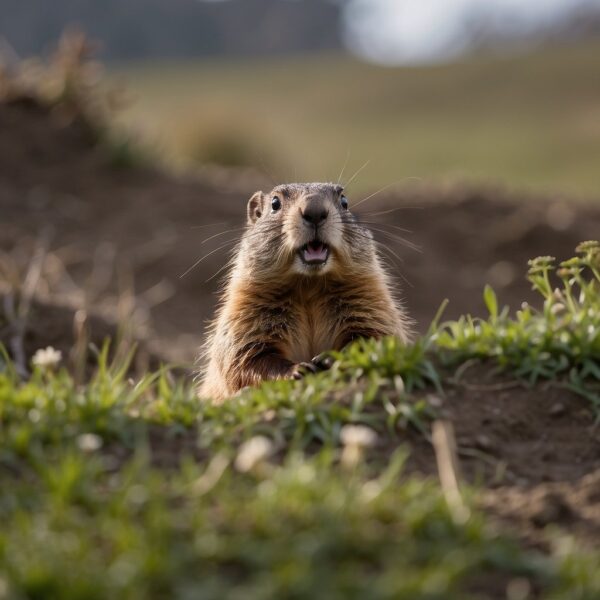
Scientific Aspects of Groundhog Behavior
The groundhog, also known as a woodchuck, is the subject of study for its behavior patterns which include hibernation, weather prediction, and a complex set of social behaviors. This section examines their biological classification, hibernation patterns, and the traditional folklore regarding their ability to predict weather.
Biological Classification
The groundhog belongs to the animal kingdom Animalia, phylum Chordata and is a member of the class Mammalia. It falls within the order Rodentia, known for species with continuously growing incisors, and is part of the family Sciuridae, which includes small or medium-size rodents. The scientific name of the groundhog is Marmota monax, and it is commonly referred to as a marmot. Conservatively speaking, this animal has not been listed as endangered and therefore has a stable conservation status.
Hibernation Patterns
Groundhogs exhibit a fascinating hibernation behavior that is essential for their survival in cold climates. As mammals, their body temperature significantly drops during hibernation, sustaining them through winter when food is scarce. They enter a state of torpor, where metabolic activities reach a minimum, allowing them to conserve energy. The process to hibernate usually begins with the onset of colder temperatures in the fall, and groundhogs will emerge from hibernation as temperatures rise in the spring.
Weather Prediction Methods
Although groundhogs do not actually predict the weather, they are at the center of a popular North American tradition called Groundhog Day. According to folklore, if a groundhog sees its shadow due to clear weather on February 2nd, it will retreat back into its burrow, indicating six more weeks of winter. Conversely, if it does not see its shadow because of cloudy weather, it signifies an early spring. The “weather prediction” is not based on scientific evidence but rather is a part of cultural entertainment.
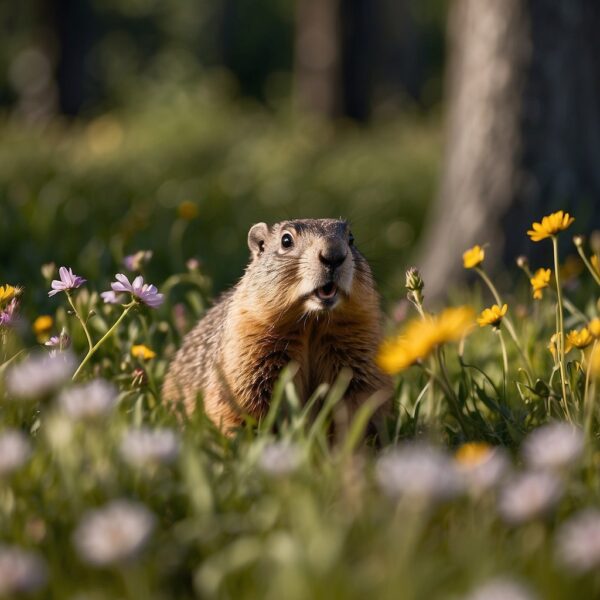
Natural Habitat and Lifestyle
Groundhogs, known for their burrowing habits, are a common sight across various regions of North America. They prefer habitats that provide ample earth for digging and vegetation for feeding.
Geographical Distribution
Groundhogs, or Marmota monax, are primarily found across North America. Their range extends from Canada to the eastern United States, and they are notably absent from Alaska. Groundhogs have adapted to a variety of habitats but are commonly associated with areas that border forests and open fields, providing them with the necessary space for burrowing and access to food sources.
Social Behavior
Groundhogs are generally solitary creatures, especially outside the breeding season. They establish extensive burrows for nesting and hibernation, with some tunnel systems having multiple entrances for quick escape and ventilation. The burrows also play a crucial role in their lifestyle, serving as a place for raising their young and protection from predators.
Diet and Reproduction
These animals are herbivores, feeding on a wide range of vegetation, including grasses, fruits, and vegetables found near their habitats. The reproductive cycle begins with the end of hibernation, with a gestation period lasting approximately one month. Groundhogs typically give birth to 2-6 young, which are raised in the safety of the burrows before venturing out on their own.
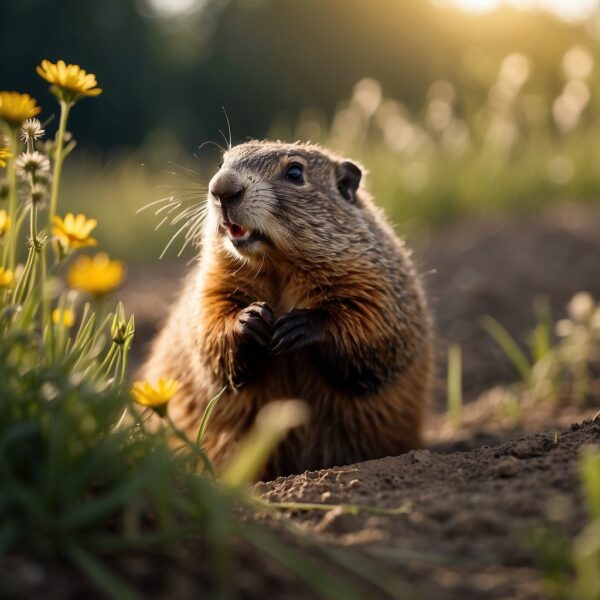
Conservation and Human Interaction
Woodchucks, have both benefited from and been challenged by human activities. Efforts to conserve their populations and manage their interactions with humans are in place due to their role in local ecosystems and occasional status as a nuisance.
Groundhogs in Captivity
Groundhogs are occasionally found in zoos where they can be ambassadors for wildlife education. In captivity, they are provided with an environment that imitates their natural habitats to a certain extent. Zoos play a role in educating the public about the life cycle and ecology of this species, although they are not typically considered endangered or threatened. Groundhogs in captivity are not common, partly because they are abundant in the wild and their conservation status is generally not of high concern.
Conservation Efforts
Conservation efforts for groundhogs mainly focus on managing their interactions with humans and protecting their natural habitats. Being adaptable creatures, they have thrived in various environments, including those altered by human development. However, these efforts are crucial when groundhog populations come into conflict with agricultural or residential areas. Measures taken include:
- Habitat management to ensure sustainable populations in the wild.
- Research into groundhog behavior and ecology to inform management strategies.
- Public education campaigns to mitigate negative views of groundhogs when they are considered pests.
By maintaining healthy populations, their ecological benefits, such as soil aeration from their burrowing activity, are preserved, promoting biodiversity.
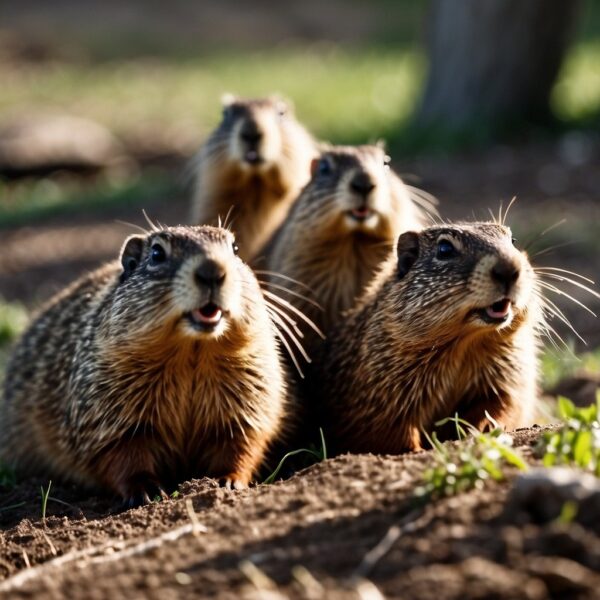
Groundhogs in Popular Culture
Groundhogs hold a notable place in North American popular culture, primarily due to the tradition of Groundhog Day, which has spawned not only widespread recognition but also iconic characters.
Famous Groundhogs
Punxsutawney Phil is undoubtedly the most celebrated groundhog in popular culture. Every year on February 2, Phil’s behavior is observed to predict the length of winter. This tradition takes place at Gobbler’s Knob, located in Punxsutawney, Pennsylvania. Phil’s prognostications draw large crowds and receive considerable media attention.
Staten Island Chuck, another prominent figure, is New York’s own weather-forecasting groundhog. Chuck’s predictions are highly anticipated and are part of Richmond County’s Groundhog Day celebration. Both Punxsutawney Phil and Staten Island Chuck symbolize a folklore where animals are believed to possess predictive abilities that mark the transition between the seasons.
Groundhog-Related Terminology and Folklore
The complex world of Groundhog Day is steeped in unique terminology and deeply rooted folklore that blend tradition with natural history. Here’s an exploration into the phrases and legends associated with this quirky holiday.
Terms and Nicknames
Groundhog: Also known as a woodchuck or whistle pig, this large rodent belongs to the group of large ground squirrels known as marmots. Despite the varied names, a groundhog and a woodchuck are the same animal, scientifically termed Marmota monax.
- Woodchuck: A common nickname derived not from the animal’s wood-related habits, but from an Algonquian name for the creature, wejack.
- Whistle Pig: A nickname that refers to the groundhog’s high-pitched warning call, which sounds like a whistle to warn others of danger.
- Chuck: A shorter, informal term occasionally used in place of “woodchuck”.
Origin of Groundhog Day Myths
The celebration of Groundhog Day every February 2nd is a fusion of nature’s rhythms and cultural beliefs. Its origins trace back to a German superstition which posits that if a hibernating animal casts a shadow on February 2nd—originally linked to the Christian holiday Candlemas—there will be six more weeks of winter.
- Candlemas: An ancient Christian festival held on February 2nd marking the midpoint between the winter solstice and spring equinox, which involves the lighting of candles as symbols of purification.
- Lore: The traditions associated with Groundhog Day echo weather lore that has circulated throughout Europe, depicting the groundhog’s shadow as a prognosticator of the winter’s duration.
- Europe/Germany: European settlers, particularly from Germany, brought similar traditions with them to America, adapting them to the native groundhog as its central figure. The Pennsylvania Dutch were among the primary groups to maintain this tradition, helping to popularize it in the United States.
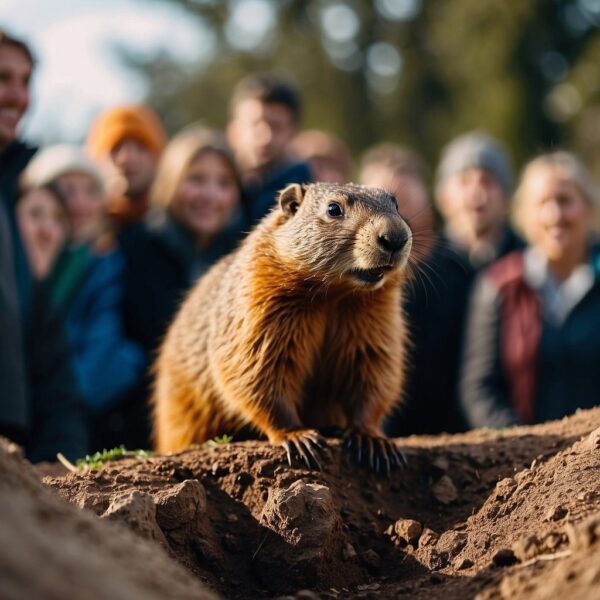
Groundhog Day Origins and Significance
Groundhog Day intertwines history, tradition, and folklore, centering on whether a groundhog can predict the coming of spring.
History and Tradition
The tradition of Groundhog Day was officially observed on February 2, 1887, in Punxsutawney, Pennsylvania. It garners its roots from German lore, where a similar practice involved a badger. The Punxsutawney Groundhog Club, founded by a group of hunters, is the principal body responsible for the celebration. This organization has an Inner Circle, a group that cares for the animal and orchestrates the annual event.
Candlemas Day
Groundhog Day shares connections with Candlemas Day, an ancient Christian festival held on February 2. Candlemas marks the midpoint of winter, halfway between the shortest day and the spring equinox. German immigrants brought a version of this tradition to Pennsylvania, which intertwined with earlier weather lore that stated if Candlemas Day was clear and sunny, winter would continue for six more weeks.
Candlemas Day Proverb:
If Candlemas Day is bright and clear,
There'll be two winters in the year.
Punxsutawney Phil Legend
Central to Groundhog Day is the legend of Punxsutawney Phil, a groundhog purportedly endowed with the ability to forecast the weather. According to the legend, if Phil emerges from his burrow and sees his shadow due to clear weather, it means six more weeks of winter; if he does not, an early spring is expected. Phil’s accuracy, while a topic of amusement and skepticism, is a cherished part of the tradition. Each year, the eyes of many are on Phil as he delivers his “prediction,” overseen by the Inner Circle with pomp and ceremony.
Cultural Impact and Celebrations
Groundhog Day festivities highlight a unique blend of tradition and entertainment in North America, making local meteorological folklore both significant and enduring in popular culture.
Festivities in North America
In the small town of Punxsutawney, Pennsylvania, Groundhog Day transforms the locality into a vibrant festival site. Punxsutawney Phil, the groundhog at the heart of this celebration, emerges from his burrow at Gobbler’s Knob to predict the weather. At sunrise, if Phil sees his shadow, six more weeks of winter are expected; no shadow signals an early spring. This moment is the pinnacle of an array of events that include:
- Live entertainment
- Grand fireworks displays
- Historical exhibits
Thousands gather from across the nation, braving the early morning chill to witness Punxsutawney Phil’s prediction, which is often covered by major media outlets, including USA Today.
Groundhog Day in Media
The cultural impact of Groundhog Day has extended into various forms of media, most notably the film starring Bill Murray. The 1993 movie “Groundhog Day” entrenched the holiday in the consciousness of the American public, thereby elevating its popularity. As a result:
- The day is commemorated in numerous television shows
- Referenced in other forms of media, echoing its place in modern American folklore
This media representation has played a crucial role in perpetuating the celebration and encouraging the festive spirit around this quirky holiday far beyond the borders of Pennsylvania.
Frequently Asked Questions
Groundhog Day is a popular tradition with intriguing aspects about the animal’s behavior and impact on culture. Here, you can find answers to some of the most commonly asked questions regarding groundhogs.
What is the significance of Groundhog Day?
Groundhog Day, observed on February 2nd, is a cultural event wherein a groundhog’s behavior is said to predict the weather. According to folklore, if the groundhog sees its shadow due to clear weather, it will retreat back into its burrow, indicating six more weeks of winter; if it does not, warmer temperatures and an early spring are expected.
What are the key differences between groundhogs and woodchucks?
Groundhogs and woodchucks are actually the same species, known scientifically as Marmota monax. The term “woodchuck” is just another common name for the same animal and does not signify a different species.
What is the typical diet of a groundhog?
Their diet consists primarily of vegetation, including grasses, fruits, and plants. They are also known to occasionally eat grubs, insects, and snails, but the bulk of their diet is herbivorous.
How big can groundhogs get?
These animals can vary in size, but they typically weigh between 5 to 12 pounds and measure 16 to 20 inches long. They may gain significant weight right before hibernation to sustain themselves during dormancy.
What should you know about the natural habitat of groundhogs?
They are commonly found in fields, pastures, and along forest edges in North America. They prefer open country and the edges of woodland, and they thrive in areas that provide a mix of green space and loose soil for burrowing.
How long do groundhogs typically live?
In the wild, they can live up to six years. However, in captivity, without the threats of predators and disease, they can live significantly longer, sometimes up to 14 years.